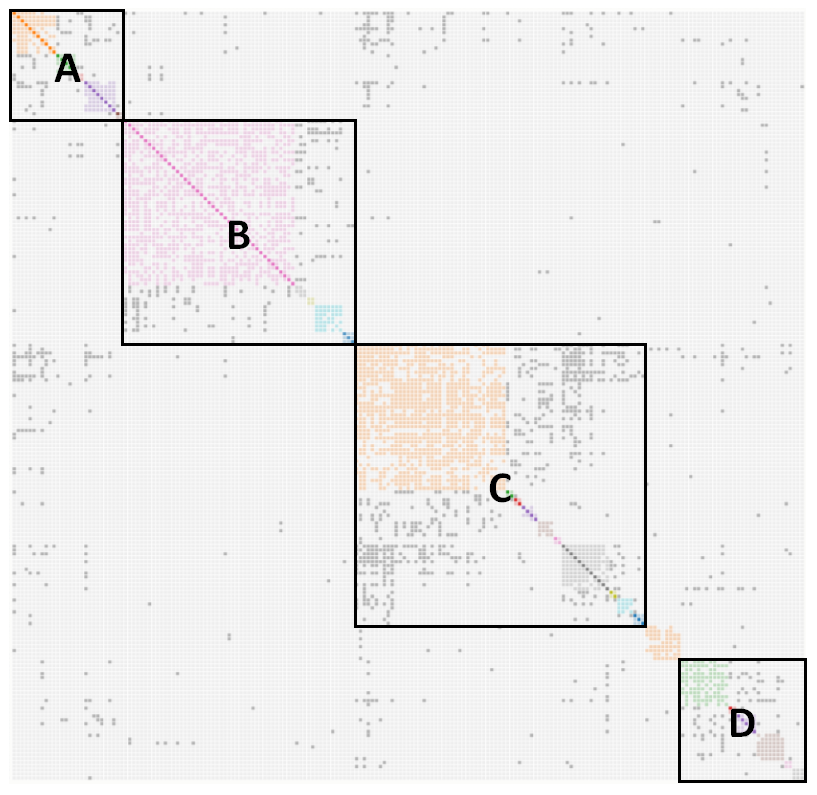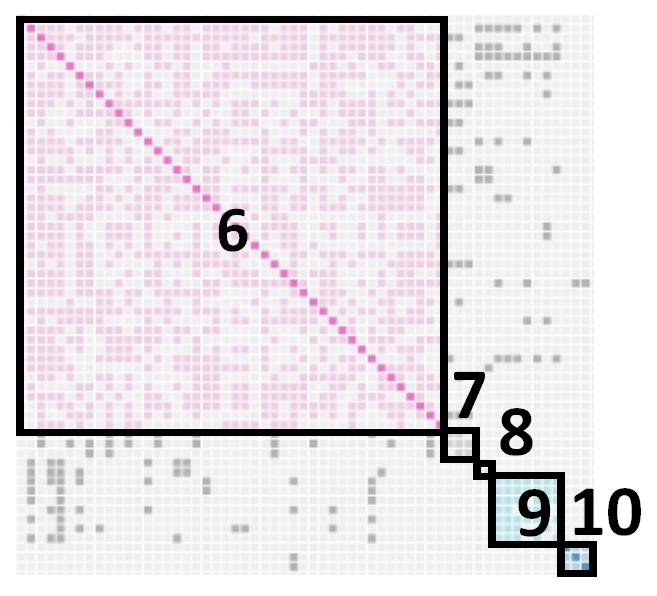This post is my second about Genetic Affairs’ auto-cluster tool and using it to analyze my paternal matches at AncestryDNA. (You can read part 1 here.) As you might recall, my father’s parents were likely first cousins, once removed (1C1R), meaning he has a high degree of pedigree collapse.
I previously identified four “super clusters” when running the auto-cluster tool on my father’s test at a range of 50 – 250 cM.

My first post examined Super Cluster A, which I determined to be Johnston/McCauley descendants. Today we will examine the next super cluster.
Paternal Super Cluster B consists of clusters 6 – 10, as defined by Genetic Affairs:

Cluster 6 (Magenta) = Horn(e)
- 43 members
- 50 – 209.4 cM
- can place 18 of 43 cousins on tree
- 5 descend from Elisha Thomas Horn & first wife Marilda Richardson
- 7 descend from their son Joshua Lawrence Horn and Rachel Harriett Yates
- 2 descend from Joshua Lawrence Horn and an unconfirmed relationship
- 3 descend from Elisha Thomas Horn & second wife Nancy Suzanna Ray
- Conclusion: This cluster contains descendants of Elisha Thomas Horn.
Cluster 7 (Dark Purple) = Horn(e)
- 3 members
- 50.1 – 65.2 cM
- can place 1 of 3 cousins on tree
- 1 descends from Elisha Thomas Horn & second wife Nancy Suzanna Ray
- Conclusion: This cluster may also contain descendants of Elisha Thomas Horn.
Cluster 8 (Yellow Green) = Richardson?
- 2 members
- 50.5 – 53.2 cM
- cannot place either cousin on tree
- 1 match has surname of Richardson
- Conclusion: This cluster may contain descendants related to Marilda Richardson’s family, but I need additional testers and the ability to place them on the tree to be certain.
Cluster 9 (Aqua) = Richardson?
- 7 members
- 50.3 – 71.3 cM
- cannot place any cousins on tree
- 1 match is a member of the Applewhite Richardson DNA circle on Ancestry
- Conclusion: This cluster may contain descendants related to Applewhite Richardson’s family, but I need additional testers and the ability to place them on the tree to be certain.
Cluster 10 (Blue) = Unknown
- 3 members
- 52 – 52.5 cM
- cannot place any cousins on tree
Parental Super Cluster B is clearly a Horn(e) cluster, possibly containing Richardson matches as well. This branch of my family is not involved with the pedigree collapse that affects my other lines. This fact is supported visually by the lack of gray “noise” dots along the X and Y axis for the cluster. (Yes, there are a few gray dots, but that’s fairly typical for anyone with deep Southern roots.)
However, a couple of these “noise” dots are worth mentioning, because they may give validity to a family theory. The two matches in Cluster 6 who were descendants of Joshua Lawrence Horn and an unconfirmed relationship also match a few members of Super Cluster A (Johnston/McCauley), specifically those in clusters 3 and 5 which contain McCauley descendants. In an August 2000 email appearing in Dr. Robert G. Horn’s book Henry Horn of Contentnea Creek, family researcher Gwen Battle Horne shared a theory that Martha McCauley was the mother of Joshua Lawrence Horne’s son from an unconfirmed relationship.¹ The shared matches depicted in this auto-cluster support this theory.
Another item of interest for Super Clusters A and B is how my second cousin, once removed (2C1R) is categorized. He and I both descend from John Thomas Horne and Georgia Smart. I would have expected him to be placed in the Horne cluster instead of the Johnston/McCauley cluster — or maybe even in another cluster that will prove to be Smart descendants. It’s curious, and I don’t have an explanation yet.
Finally, I wonder why so many matches in this super cluster are unidentified. Elisha Thomas Horn’s parentage is unknown; therefore, some of these mystery matches — especially the ones in smaller cluster 10 — could be descendants of his unknown siblings. They may also be Richardson family. Unfortunately, very few trees are built out to the 5 – 6 generations necessary to identify a common ancestor when working with these smaller amounts of shared DNA.
¹ Dr. Robert G. Horn, Henry Horn of Contentnea Creek (Cornersville, Tennessee : self-published, 2006), 208-10.

I am so excited that you are trying out this analysis technique and that it is both working and giving you insight! I hope others will give it a try and let me know how it works out for them. 🙂
My original posts on this type of analysis can be found in these two posts:
https://www.danaleeds.com/analyzing-a-cluster-chart/
https://www.danaleeds.com/analyzing-a-supercluster-chart/